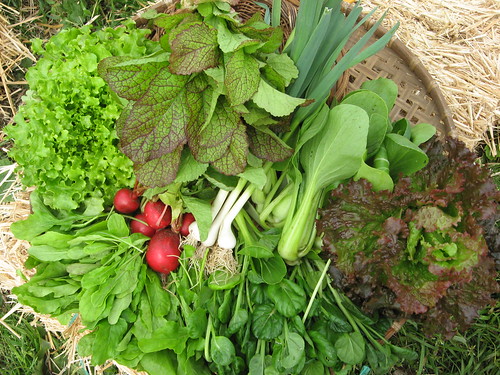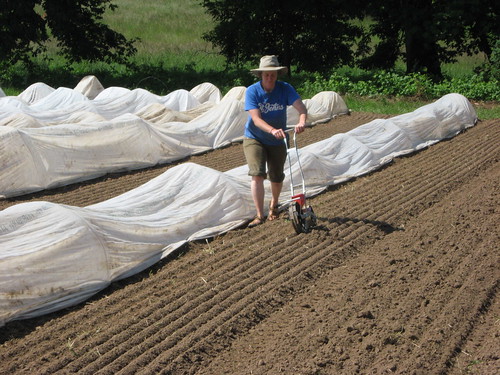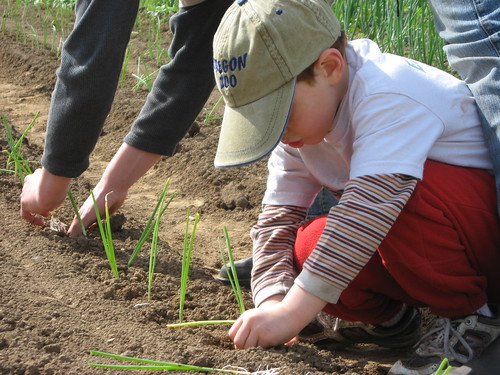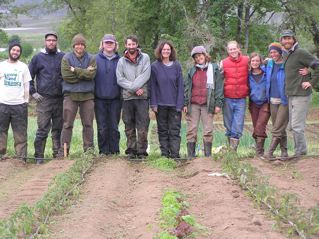
This week’s share
- Broccoli
- Cooking Greens
- Fennel
- Garlic Scapes
- Lettuce
- Mizuna
- Onions
Broccoli- I hope you have been enjoying the broccoli as much as I have enjoyed harvesting it for your shares. Broccoli is harvested first thing in the morning, we walk down between the rows, knife in hand, pausing to inspect the large heads. How’s the size? How’s the color? Too tight? Too loose? Just right! Whack and a toss over the shoulder into the broccoli back pack and on to the next plant.
Cooking Greens- Cooking greens are delicious way to get your vitamins, they are high in calcium and make a great side dish. Top with chopped and sautéed garlic scapes and walla walla onion, butter, lemon juice or vinegar with salt and pepper for a quick and easy side dish.
Fennel- Fennel will make its debut in your share this week, we grow two plantings of fennel a year- one in the spring and one in the fall. Enjoy this delicious lightly licorice scented and flavored vegetable cooked or raw. Try it simply sautéed in butter until tender for a decadent dish. I am a fennel fanatic and slaw addict so below you will find one of my favorite recipes combining the two.
Garlic Scapes- Garlic scapes are one of my favorite spring treats, they are here for such a short time and give us the garlic we crave before the bulbs are ready. Garlic scapes are the immature flower buds of the plant, we pinch them so the plant can focus it’s energy into producing large bulbs. Fire up the grill and toss the garlic scapes with olive oil and a pinch of salt, they take only a few minutes on the grill to become tender and are of a milder garlic taste than the green garlic.
Lettuce- We grow many kinds of lettuce here at the farm, it is one of our mainstays in our CSA bounty, indispensable for it’s versatility. Try it with different salad recipes and no sandwich is complete without it.
Mizuna- Mizuna is one of our key salad mix ingredients, it is milder in taste than the more familiar arugula. This makes it good companion to many tastes be it sweet or savory, my favorite recipe combines the both and is listed below in the recipes.
Onions- Walla Wallas are the sweetest, juiciest onion you’ll ever taste. I’ve been dreaming of walla walla onion rings since the onion starts went into the ground and now their finally ready. They are so sweet you  can eat them raw, though I highly recommend sautéing or grilling them with a little olive oil and salt and pepper. They make a great addition to just about any meal.
can eat them raw, though I highly recommend sautéing or grilling them with a little olive oil and salt and pepper. They make a great addition to just about any meal.
Coming Soon: Carrots
Crisp and sweet the first carrots of the season are on their way.
Recipes
Fennel Slaw
- 2 tablespoons apple cider vinegar
- 1/3 cup mayonnaise
- 1/2 teaspoon freshly ground black pepper
- 2 teaspoons sugar
- 1/2 teaspoon finely grated lemon zest
- 1/8 teaspoon salt
- 1 tablespoon of caraway seeds
- 2 bulbs of fennel thinly sliced
Whisk together all ingredients except fennel in bowl. Add thinly sliced fennel and toss until evenly coated. Season with additional salt and pepper as desired.
Mizuna Strawberry Salad
- 3 tablespoons sugar
- 3 tablespoons mayonnaise
- 2 tablespoons milk
- 1 tablespoon poppy seeds
- 1 tablespoon apple cider vinegar
- 1 bunch of mizuna
- 1 cup of strawberries
- crumbled goat cheese (as desired)
- chopped walnuts (as desired)
Combine first five ingredients in a bowl and whisk together to make the dressing and set aside. Place the mizuna on plates and sprinkle with the strawberries, walnuts and goat cheese. Drizzle with the dressing.
(Many seasonal fruits work well with this, so experiment and enjoy)
Introductions
Those who pick up their shares at the Wednesday SE Elliott site may know me, I alternate weeks with Scott our field assistant. For those members who I haven’t met I’m Becky and I am a second year apprentice along with Vanessa. As of May 1st we experienced an entire year at Sauvie Island Organics and are now entering the final season in our 17-month apprenticeship. It has been and is a truly amazing experience, education through hands on work, practicum and classes. I got my first taste of farming in 2001 working at a small farm in Massachusetts. I moved to Portland 3 years ago and was inspired by the agricultural scene. When I first heard about CSA farming I was immediately curious to find out how it worked. Over the past year I have come to learn the value of a CSA, of building a direct relationship between the farmer and those eating the beautiful food we grow.
Flower Shares
This winter I spent much of my time working on the flower share planning for the 2007 season. With the help of Tanya we experimented with creating a flower share projection similar to how we plan our food crops. This involved me awakening math skills long dormant in my brain to figure how many stems can each plant produce based on its growing habits and seasonality. This then led to how many to seed in the greenhouse thinking far along and taking into consideration some wouldn’t germinate, some would get eaten by birds and perhaps a few would die in the field. So with a cushion on the flower count and an armload of paper work I placed the seed orders based on what flowers have proven themselves to be sturdy enough and long enough for cutting, have a decent vase life (my goal is a week) and can produce nice re-growth or be easily planted in succession, and most importantly be easy on the eyes. This week the final seeds were started in the greenhouse and the last plant out will coincide with the first harvest. Every week will feature a unique arrangement to show off the colors of the season as it progresses. There are still a few flower shares left, the share is for ten weeks and starts the first week of July. The cost of the flower share is $150. Contact the office if you would like to sign up.
Field Notes
 This week the peppers left the warmth of the green house to be planted out next to the eggplants, both are snug now under their billowing sheets of remay protecting them from the cool nights that are still upon us. The remay came off the summer squash revealing plants doubled in size since they were transplanted two weeks ago and free of cucumber beetles, there are already a few squash flowers and you can anticipate seeing them in your share in just a few weeks. The onion fields are almost all weeded but as the crops grow so does the weeding list, high on priority are the broccoli and potatoes. The last of the tomatoes are being staked and some are soon to be taller than some of us farmers and we are tying and wheel hoeing weekly. Our first corn planting is shin high, right on schedule for knee high by the fourth of July. I know I already mentioned the carrots but carrots are almost here, so are the beets!
This week the peppers left the warmth of the green house to be planted out next to the eggplants, both are snug now under their billowing sheets of remay protecting them from the cool nights that are still upon us. The remay came off the summer squash revealing plants doubled in size since they were transplanted two weeks ago and free of cucumber beetles, there are already a few squash flowers and you can anticipate seeing them in your share in just a few weeks. The onion fields are almost all weeded but as the crops grow so does the weeding list, high on priority are the broccoli and potatoes. The last of the tomatoes are being staked and some are soon to be taller than some of us farmers and we are tying and wheel hoeing weekly. Our first corn planting is shin high, right on schedule for knee high by the fourth of July. I know I already mentioned the carrots but carrots are almost here, so are the beets!
Apprentice Rotations
As second year apprentices Vanessa and I get to take on more responsibility in the operation of the farm. There are three rotations that we switch off so we can gain as much experience and knowledge as possible before we graduate and apply our new found skills towards our goals.
Field Jedi- Field Jedi coordinates with Scott our field assistant and is responsible for mixing and spreading of soil amendments, the irrigation of crops by drip tape or overhead watering, everything on the farm needs an inch of water a week, this makes for a tight watering schedule and a lot of laying out drip and moving pipe as crops get planted out into the field. Field Jedi is also responsible for the management of our compost piles.
Greenhouse- Greenhouse rotation manages the daily opening and closing of the greenhouse and maintaining of proper temperature, airflow, and watering needs of all our seed starts. We seed all of our crops according to the farm’s schedule which is planned out over the winter. We keep records on all greenhouse seedings to ensure we get the right count to be planted out in the fields.
Barn Owl- Barn Owl is responsible for keeping the yield records of the crops as they are harvested, we weigh and wash and pack and divide up the goodies for all our CSA members and the restaurants we sell to. In addition to this Barn Owl gets the opportunity to go on Friday morning field walk with the managers, this is when we set the week’s harvest and make our weekly to do list.
Egg Notes
Just a reminder to those who receive egg shares, if you share a dozen egg share please make sure you take a full dozen to split with your share partner. Pre-packed half dozens are for those who ordered a half-dozen share. In addition Kookoolan Farms can only take back their own egg cartons. We will gladly take the cartons back and return them. We cannot accept egg cartons that are not from Kookoolan Farms.
Sharing a Share
If you share a share make sure you coordinate with your share partner, if you are the one picking up you can put your share partners half in a paper bag provided at the pick-up and write their name on the bag.
Compost Buckets
Please remember to bring back your compost bucket each week to replace it with a fresh one. We gladly will take all your vegetable and fruit scraps as well as coffee grounds and filters, tea bags, eggs and egg shells, bread, dairy (in small amounts) leftovers without meat. Please do not compost any meat, fish, bones, paper, rubber bands, plastic or other non compost items.






 CSA member Amy Aycrigg runs City Dog, Inc. She welcomes dogs into her home for kennel-free boarding where they become part of the family. Your dog will enjoy walking in the neighborhood on leash or going to Forest Park for a romp. Four-legged guests are given plenty of TLC. Amy’s family includes Kathy Saunders, who works for the City of Portland, China their 12 year old Australian Shepard, and 2 cats-Tinto and Patches. Email Amy at
CSA member Amy Aycrigg runs City Dog, Inc. She welcomes dogs into her home for kennel-free boarding where they become part of the family. Your dog will enjoy walking in the neighborhood on leash or going to Forest Park for a romp. Four-legged guests are given plenty of TLC. Amy’s family includes Kathy Saunders, who works for the City of Portland, China their 12 year old Australian Shepard, and 2 cats-Tinto and Patches. Email Amy at 














